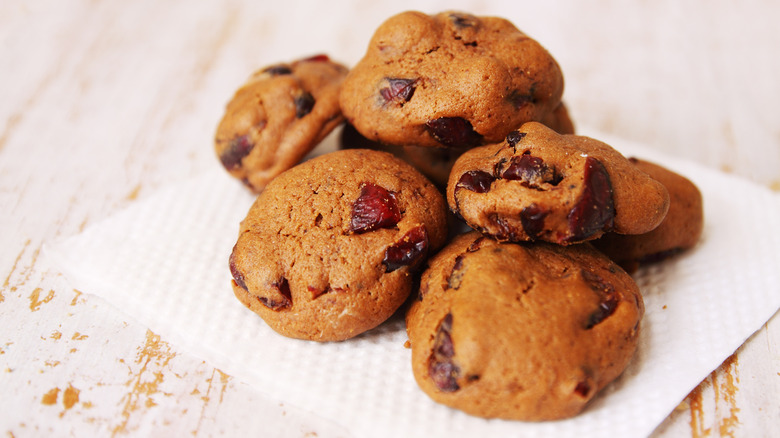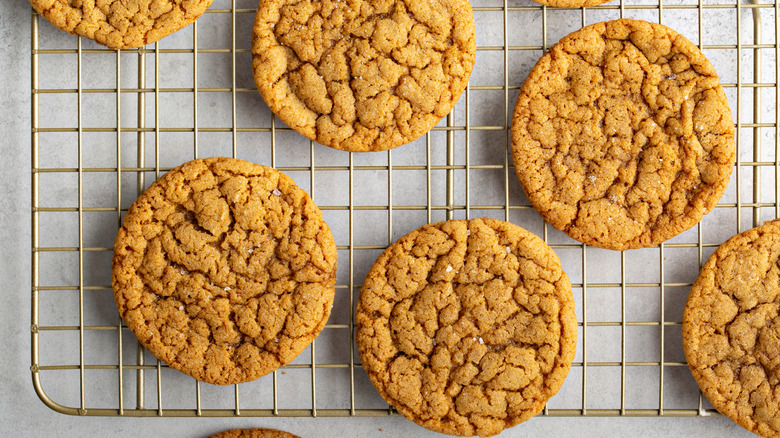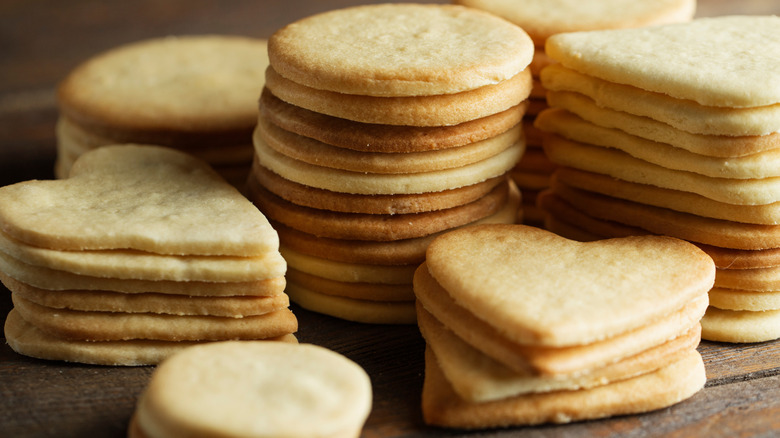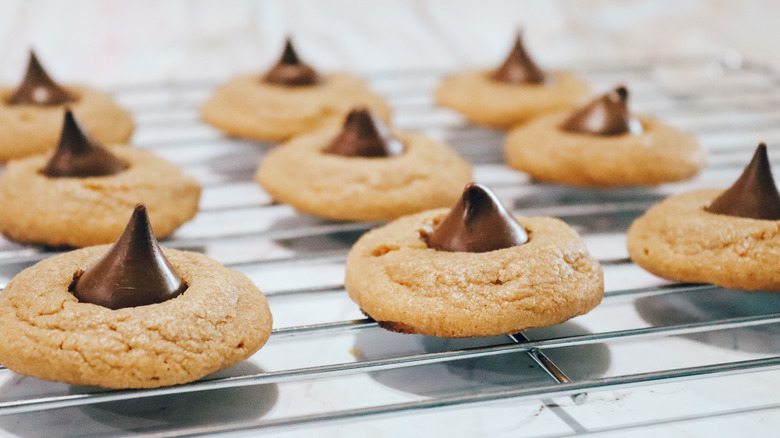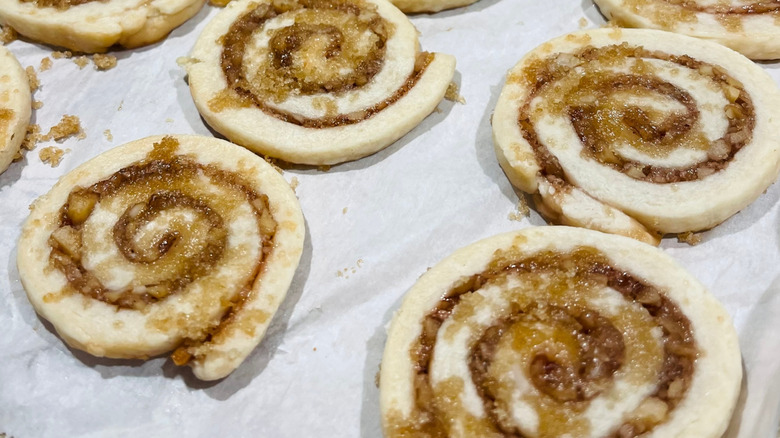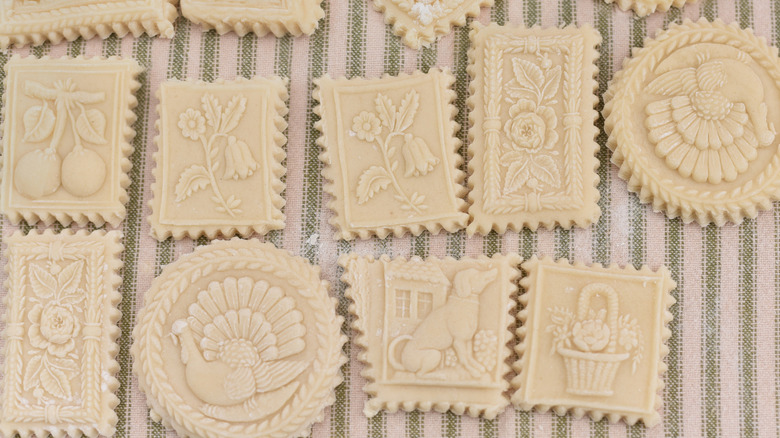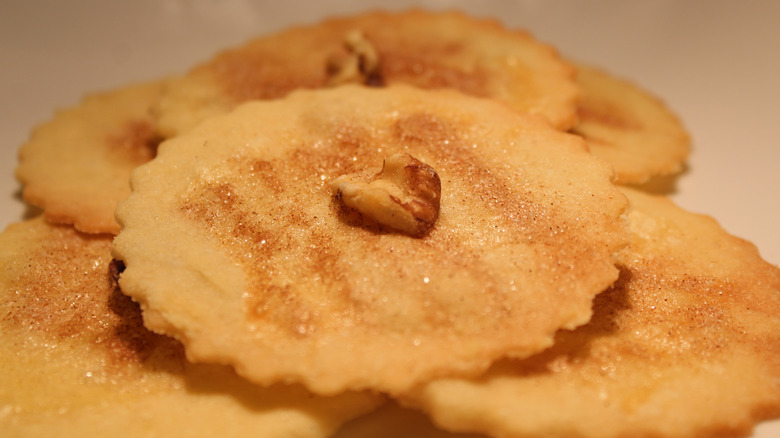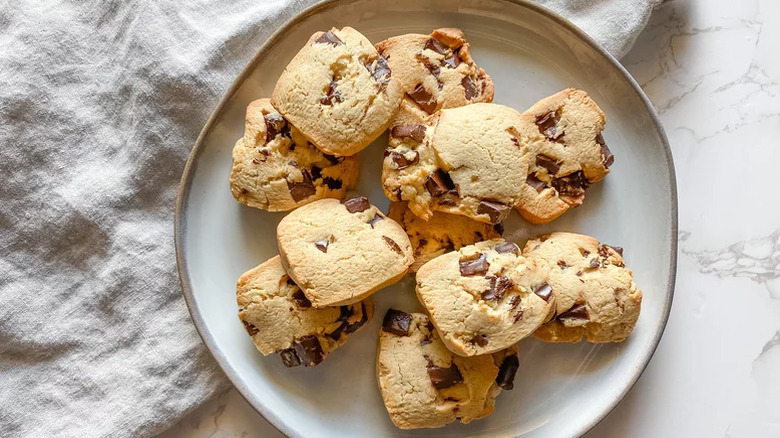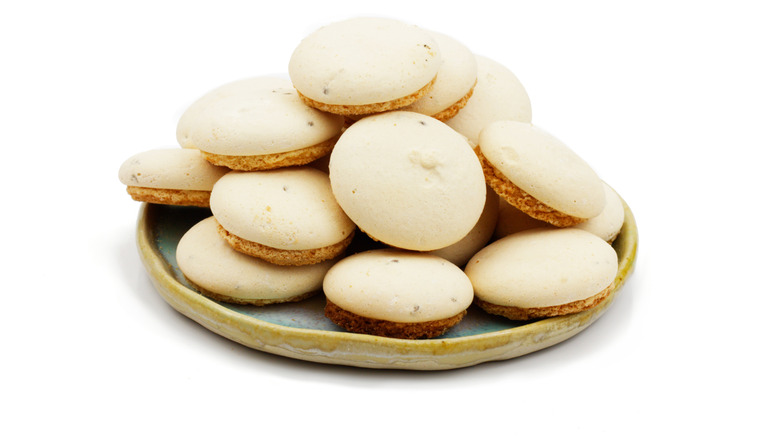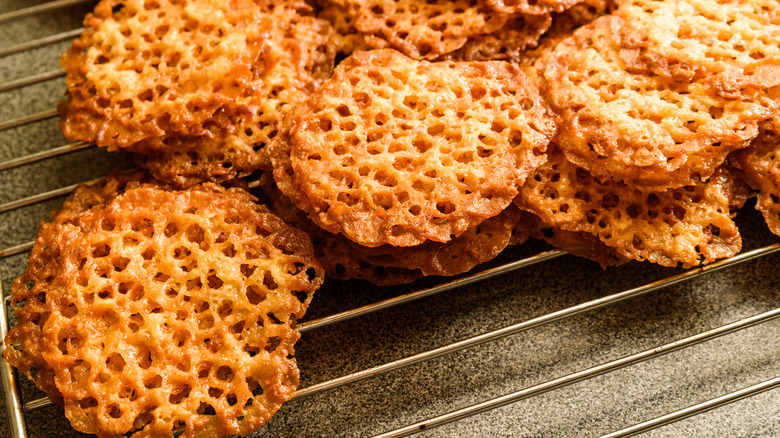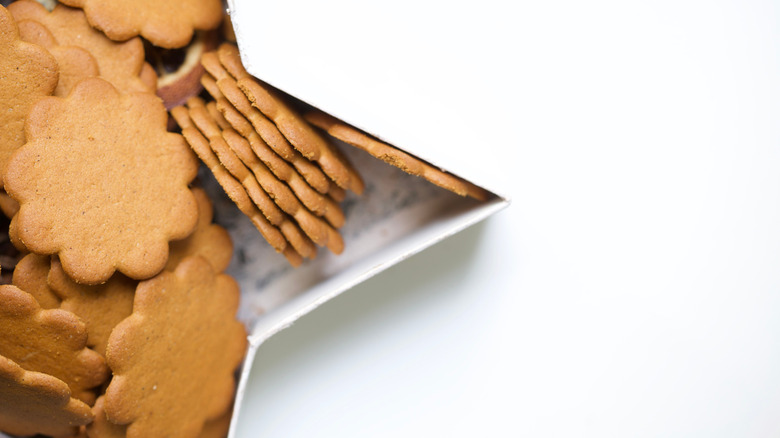Vintage Cookies That Need To Make A Comeback
We can all agree that cookies are brilliant, whether the understated brilliance of a ginger snap or the all-out indulgence of a double choc chip, still warm from the oven with a gooey center. We all have our favorites among today's popular choices, but there are some vintage cookies that need to make a comeback.
With so many options out there and new recipes being developed all the time, it's natural that some fall by the wayside over the years. But there's nothing wrong with them. In fact, there's a lot right with them, and we'd love to see them return in full force. Retro recipes don't have to be resigned to the past. And they're not always gimmicky. Most of them are just old-fashioned classics that have had their day come and go.
But trends change and cycle and we think it's about time these vintage cookies returned to bakeries and home kitchens everywhere. The great thing about it is that we have some control over whether or not they come back into our lives. If you want to try any of these old-school cookies, just gather your ingredients and get baking.
Hermit cookies
Nobody's quite certain where hermit cookies got their name, but you're going to want to hide in your shell like a hermit crab so you don't have to share once you whip up a batch. They date all the way back to the 19th century, before the days of refrigeration, so they're designed to last for a long time at room temperature.
But what exactly is a hermit cookie? It's soft and slightly cakey, and filled with dried fruits and nuts. The sweetness level is moderate, about on par with a granola bar. So, for a cookie, it's on the nutritious side. Don't let that put you off, though, because hermit cookies are delicious.
Our hermit cookie recipe contains chopped dates, raisins, and chopped walnuts. It gets its flavor from cinnamon and nutmeg, plus caramel notes from using brown sugar, rather than white. There's also a bit of vanilla extract in there to round things out. Like many cookies, they're easy to make. After beating together the ingredients — starting with the butter and sugar — you roll them into golf ball sized spheres and bake for 15 minutes. It's really that simple. Despite being vintage, they feel pretty contemporary in a classic way.
Molasses crinkles
Molasses crinkles deserve a place in your cookie jar, and not just for the sake of nostalgia. With their chewy centers, crisp edges, warm spice profile, and signature crackled top, they're worth going out of your way to get reacquainted with. Once a staple in mid-century American kitchens, they got cast aside for richer chocolatey cookies, but it's high time they made a return.
The molasses is key here as it brings a rich, earthy sweetness that brown sugar alone can't match. They're also filled with sweet spices that make you think of Christmas mornings — although they're delicious year-round. Spice choices can vary between recipes, but ginger and cinnamon usually make a showing. They have a deep flavor but it's understated rather than showy, so they're great for morning coffee breaks or an after dinner treat alike.
We also appreciate that molasses crinkles are remarkably easy to make. You cream together butter or shortening and sugar, add in eggs and molasses, then fold in your flour and spices. After forming balls from the cookie dough, you roll each one in sugar before baking. This gives them an extra-crackly exterior that's a big part of their appeal. If you're looking to revive a vintage cookie that genuinely earns its place, molasses crinkles are a great place to start. They're classic, but not dated, and appeal to anyone who loves holiday spices.
Jumbles
The name sounds mid-century quirky, but jumbles date back hundreds of years. They were particularly popular in the 17th and 18th centuries, when they were also called jumbals or jumballs. And there are even more variations on their ingredients than there are on their spelling, which is natural for such an old recipe.
One thing jumbles have in common is that they're spiced. Recipes contain a blend of sweet spices, such as mace, allspice, anise, and nutmeg. Some historical recipes even included coriander, which sounds odd by today's standards, but it has bright zesty notes that can work well in sweet recipes. Rose water is another common addition to add more flavor. These were invented at a time when vanilla was rare and expensive, but rose water was more readily available.
The texture sets these cookies apart from other similar options. They're not quite as crisp as a gingersnap, nor as soft as a sugar cookie, but something in between. That perfect balance comes from the careful ratio of butter to flour, creating cookies that have just enough structure to hold together while maintaining that coveted tender crumb. Like many vintage treats, jumbles have practical origins. They were designed to be sturdy enough for travel and storage, making them perfect for packed lunches or care packages.
Peanut butter blossoms
The history of peanut butter blossoms is more recent than some but still firmly in vintage territory. They were invented in the 1950s, by Freda Smith from Gibsonburg, Ohio. When baking for her grandkids, Smith realized she didn't have any chocolate chips. So, instead, she pressed a single Hershey's kiss into the center of each cookie when it was baked but still warm from the oven.
It soon became a family favorite, so she entered the recipe into the 1957 Pillsbury Grand National Recipe and Baking Contest. She wasn't the overall winner but she did go home with a prize. Even so, the recipe was a hit — it was included in two cookbooks related to the contest and became a nationwide favorite. There was a time when these cookies were found at pretty much every potluck and school bake sale. Today, they're much less popular. You might have a grandparent who still bakes them for the holidays, but they're far from everywhere.
We think it's time for a comeback, though. They're way easier to make than they seem and they taste amazing. Our four-ingredient peanut butter blossom recipe is about as simple as they come.
Date pinwheels
Date pinwheels look impressive on a plate but are far less fussy to make than you might think. They were a popular choice throughout the mid-20th century, especially at holiday gatherings, but you don't need to wait for a special occasion to enjoy them. With their spirals of dough wrapped around a tasty date filling, they're a little more complex to make than some cookies, but they're still relatively easy for a confident home baker.
The balance of textures and flavors makes them worth revisiting. The dough is buttery and lightly sweet, providing just the right structure to encase the filling without overwhelming it. The dates bring a rich, caramel-like depth. Overall, they're well balanced with classic flavors that don't taste out of date.
If you're wondering how to get that spiral, it's not too tricky. You roll out the dough, spread on the date mixture, and roll it up into a log before slicing and baking. Anyone who's made cinnamon rolls will be familiar with the process. What you end up with is a cookie that looks bakery-worthy but isn't too complex to pull off.
There are other variations on the pinwheel cookie if dates aren't your jam. You can use other dried fruits, cinnamon sugar, jam, and anything else that takes your fancy. We have an old-fashioned pinwheel cookie recipe that swirls together two flavors of cookie dough: vanilla and chocolate.
Springerle
If you've never encountered springerle, you're missing out on one of Europe's most impressive cookie traditions. These German anise-flavored bakes are as much about how they look as how they taste, featuring intricate embossed designs. Dating back to the 14th century, springerle were originally created for religious festivals and special occasions. Today, they're mostly considered Christmas cookies. But, outside of Germany, it's time for a comeback.
They're not easy to make at home, though, unless you have the right gear. After rolling the dough, you press it with carved wooden boards called springerle molds, which create the distinctive raised patterns. Then comes the crucial overnight drying time, where the cookies sit out, allowing the surface to form a protective shell. This helps the designs stay crisp and defined during baking, emerging from the oven looking like edible works of art.
If you're unfamiliar with continental European baking, they may be an acquired taste. Anise gives springerle a licorice-like flavor, though it's relatively subtle. The texture can vary between recipes, from very hard to crisp on the outside but soft and chewy inside. They're not overly sweet, so they're often enjoyed with tea or coffee.
Jam thumbprints
Whatever happened to jam thumbprints? Once upon a time, you'd find them at every coffee morning or as part of every holiday cookie spread. But now you rarely find them anywhere. They're fallen out of favor big time, but we'd love to see them return to the fold.
These treats have Scandinavian roots and were once seen as pretty sophisticated. Times have moved on, and cardamom buns and semla are more trendy — but surely there's still some room for these grandma cookies (and we mean that in a good way). After all, they've got a lot going for them. They've got an excellent texture that's crumbly and melt-in-the-mouth, not too far off shortbread. Then there's the jam-filled thumbprint. You can use any flavor of preserve you like, when something classic like strawberry or more unusual like rhubarb and cardamom.
An average Swedish thumbprint cookie recipe involves mixing up the dough, forming it into balls, then using your thumb to make a well. You then put jam in the well and bake. It's pretty straightforward for something so delicious. And you don't have to stop with jam. You can also fill the thumbprint with ingredients like caramel or chocolate ganache.
Sand tarts
Despite the name, sand tarts aren't tarts at all — they're straight up cookies. Somewhere in between a sugar cookie and shortbread. The name comes from a slightly sandy "short" texture, which doesn't sound all that appealing, but stick with us. They're a Pennsylvania Dutch specialty, but one that used to be much more common nationwide. Today, they're something most people haven't even heard of, and we want that to change.
These cookies are thin, crisp, and buttery. They're sweet but not overly so. Sand tarts are rolled out paper-thin, cut into shapes with a cookie cutter, brushed with a bit of egg wash, and sprinkled with cinnamon sugar before baking. A single pecan, or sometimes other nut, on top is a classic finishing touch. Their texture is a big part of the appeal, shattering slightly with each bite.
They're also flexible enough to fit into modern baking routines. While some recipes call for an overnight rest in the fridge to make rolling easier, others can be made start to finish in an afternoon. If you enjoy a hands-on baking project, rolling and cutting sand tarts can be almost meditative. And yes, it takes a little longer than scooping dough or rolling it into balls with your hands, but it's worth it for the thin, delicate cookies you end up with.
Icebox cookies
Icebox cookies are an old-school type of sugar cookie that involves a dough that needs to be chilled in the fridge before baking. It's an extra step, but your patience will be rewarded. You can't whip them up in 30 minutes but it's worth the wait. These cookies are vintage enough that they come from a time when a fridge was called an icebox, which tells you a bit about their retro credentials.
There are no set fillers that have to go in an icebox cookie. The basic dough recipe contains the usual suspects — sugar, flour, butter, eggs, vanilla extract, and leavening agent — but the mix-in options are up to you. Our old-fashioned icebox cookie recipe contains chocolate chips — a classic choice — but you could mix in nuts, sprinkles, dried fruit, spices, crushed pretzels. It's up to you.
What makes these cookies is the method rather than the precise ingredients. After mixing up the dough, you form it into logs and chill them for at least four hours, but ideally overnight. After chilling, you slice the log into rounds and bake them right away.
Anise drops
Anise drops might just be the most misunderstood cookies in the vintage lineup. Sure, anise has a polarizing flavor — you either love that distinctive licorice taste or you don't — but these retro bakes deserve more credit than they get. Popular throughout the 19th and early 20th centuries, they were once a staple in bakeries and with home cooks. Today, they've practically vanished, which is a shame because they bring something completely different to the table.
They might have a notable flavor, but their texture also makes them special. These aren't typical drop cookies. They start with a meringue-like base that gets its lift from beaten eggs rather than chemical leaveners like baking powder and baking soda. This leaves you with a crunchy top layer that's a little like a French macaron, but with a cakier center. It's a texture you just don't find in modern cookies.
How you prepare them matters. They require patience. Once the raw dough is dropped onto parchment, it needs to sit out overnight before baking. During this time, the dough develops a skin that helps create that distinctive texture. Don't write them off if you think you dislike anise, either. The flavor is much more subtle in cookie form than you might expect, especially when balanced with a touch of lemon zest or almond extract. They're delicate and sophisticated, and we think it's prime time for a comeback.
Oatmeal lace cookies
Sometimes the most humble ingredients can transform into an elegant treat. Oatmeal lace cookies are proof of that. These delicate treats were once seen at every fancy dinner party or luncheon, to go with tea and coffee. But somewhere along the way, they got overshadowed by more substantial cookies. But we would love to see them brought back.
They're made from a simple mixture of oats, butter, sugar, egg, and just a couple of tablespoons of flour to hold everything together. Due to the high butter and sugar content and minimal flour, the mixture spreads impossibly thin in the oven. That's where the "lace" name comes from — they bake up with tiny holes and a lacy pattern that makes them look like edible doilies. They have a crisp, slightly chewy texture and buttery flavor.
We love how versatile these cookies are. You can eat them straight-up with a hot drink or use them as gorgeous garnishes for ice cream and desserts. Some bakers even drape them over rolling pins while they're still warm to create curved tuile-like shapes. The recipe does require a bit of finesse — you have to time things carefully so you get the perfect bake without a burned sugar taste. But once you master them, you'll wonder why they ever fell out of fashion.
Moravian cookies
Wondering what Moravian cookies are? Well, they're the treat that once put Winston-Salem, North Carolina on the map. The most famous ones were made by the Wilkerson Moravian Bakery but it comes from an old recipe from the 1700s, when Moravian settlers brought their baking traditions to the region from Europe.
Wafer thin and delicate, these cookies are spiced with a blend that usually includes ginger, cinnamon, cloves, and sometimes cardamom or nutmeg. What started as a local specialty deserves to make a comeback and be just as popular across the nation as they are in North Carolina. They're a little like lebkuchen meets a typical American gingerbread cookie.
The secret to Moravian cookies is rolling them thinner than you ever thought possible. They should be incredibly thin and light and you only get this from rolling the dough right. Making them at home requires patience and a good rolling pin technique, but the results are worth every minute spent getting that dough paper-thin. Some bakers swear by chilling the dough between rollings, while others prefer working with it at room temperature. Either way, you'll need to commit to the process — you can't rush these cookies.

